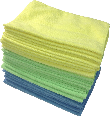The first thing to do when trying to clean a laptop is to turn it off. Unplug and remove the battery of your computer. That having been said, the steps to getting a laptop are pretty straightforward and basically in the same vein in most laptop cleaning instructions. Of course, always check your computer's user manual for the best instructions, but as far as generic instructions for most laptops go, here's the skinny:
Part One: The Outer Laptop
Wipe down the whole laptop case with a soft cloth, such as a piece torn off an old t-shirt. Don't use anything abrasive on any of your computer, whether it is a cloth, sponge, or cleanser. Generally, it's recommended that you clean off the casing with only water, but if you're having trouble with an especially tough spot of grime, just place some rubbing alcohol on your cloth and clean with that. Never pour or spray cleaning fluid (even water) directly onto your computer. You can do a lot of damage if liquids seep into the cracks of your computer and go where they should not.
Even if you do not eat or drink directly beside the keyboard, you can get stuff like crumbs in it. Clean the keyboard by using that little miracle of geekdom, compressed air in a can, to blow away residue. Your User Manual will let you know if you can open your keyboard to clean inside or remove keys to clean individually. Cotton swabs are helpful in both of these endeavors.
The screen can best be evaluated for dirt when it is turned off (and it will be if you have unplugged it like I have told you to do). Use a soft cloth for this part of the computer as well. Your laptop display will not look good if you attempt to use paper towels, tissues, or toilet paper to clean it, so do not do so. A cost-effective and easy-to-make cleaner can be made of one part isopropyl alcohol to one part water. Ammonia-based cleansers will leave a film, so avoid using those.
Cleaning the touchpad is pretty simple; just wipe it off with the soft cloth you used on the other parts of your computer.
Part Two: The Innards of the Laptop
Spray the vents of your laptop computer with compressed air, taking care not to get any liquid on the fan blades and avoid spraying on the fans themselves because that can over-spin your blades and harm—possibly even destroy—your fans. Cotton swabs again come in handy when you need to hold the fan blades in place while you clean them. You can also use a toothpick to hold them in place.
Use compressed air and cotton swabs to clean out the I/O Ports, but take care that you do not compound the problem by blowing dirt into the ports.
Anything deeper than this, such as cleaning the heatsink, cannot be covered in this article, since every laptop computer is different. If you think it's still dirty after you have done all you can, consider taking it to a specialist to have it serviced.

The Power of Microfiber! Zwipes Microfiber Cleaning Cloths will become your favorite tool for every cleaning task. This 36-cloth package is perfect for hundreds of uses in the garage, kitchen, bathroom, laundry, and all around the house. Each cloth is tough, streak-free, lint-free, reusable, and washable. Check out Microfiber Cleaning Cloths today!
Your keyboard is a vital part of your computer. By keeping it clean, you can ensure that it will continue to work well.
Discover MoreIf your laptop is over a year old, and you notice that it isn't running well or makes loud noises, then it may be time to ...
Discover MoreDue to the reduced size and weight of LCD computer screens they have become increasingly popular in both the home and ...
Discover MoreFREE SERVICE: Get tips like this every week in Cleaning Tips from Tips.Net. Enter your address and click "Subscribe."
2024-10-07 21:40:45
Ruth E Matthews
I find your tips very helpful !! I am 89 years old and find that many things do not
make sense to me no matter how hard I try. I can pick what I want to read about
from your tips. Thank you very much.. Ruth Matthews
FREE SERVICE: Get tips like this every week in Cleaning Tips from Tips.Net. Enter your address and click "Subscribe."
Copyright © 2025 Sharon Parq Associates, Inc.
Comments